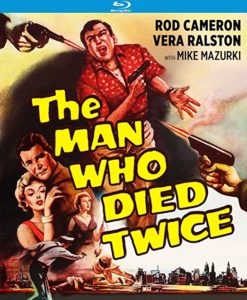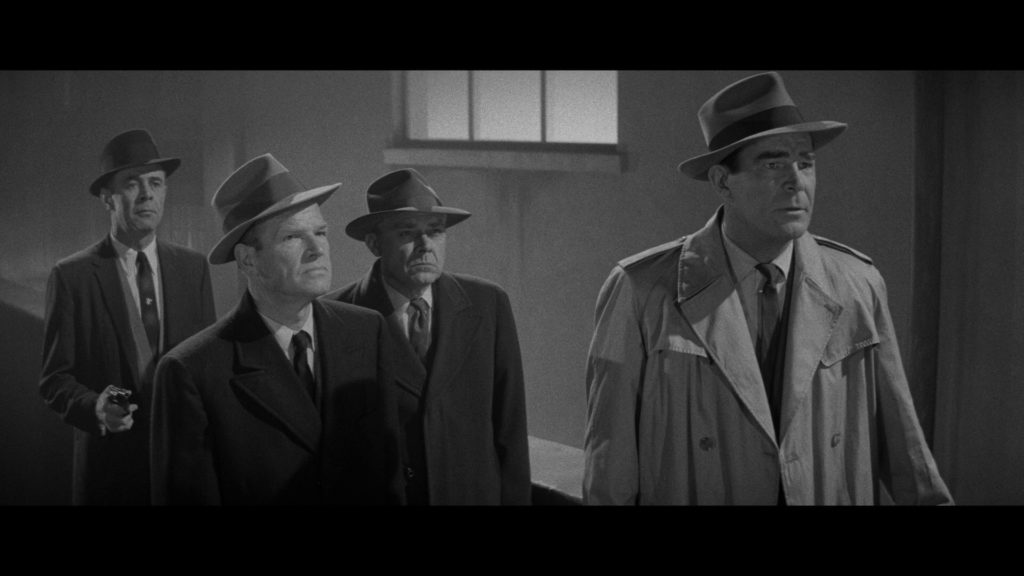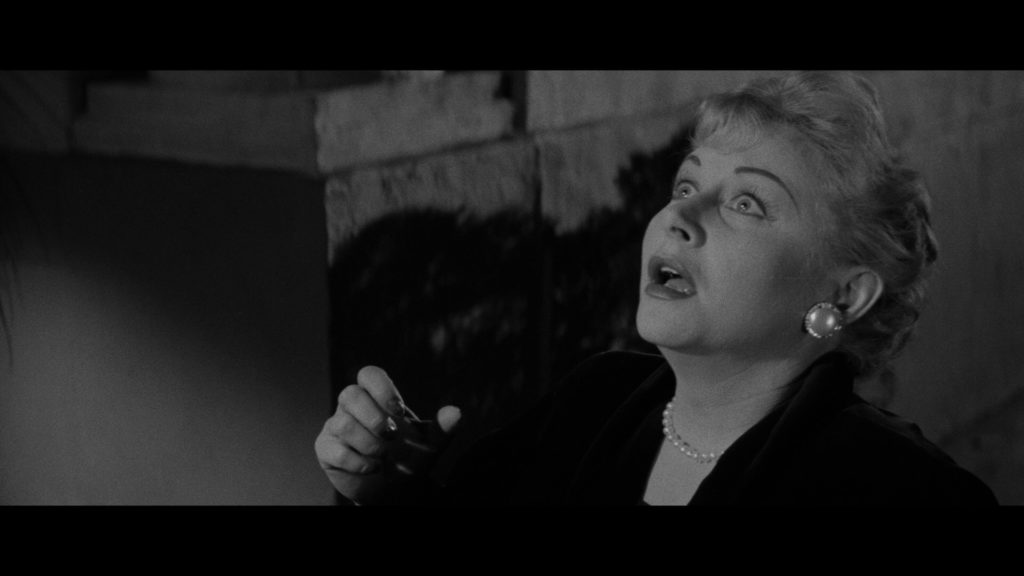The Man Who Died Twice 1958 Movie Review
Once is Never Enough for This Agglomeration of Interchangeable Toughs
DIRECTED BY JOE KANE/1958
STREET Date: Nov xiv, 2017/KINO LORBER STUDIO CLASSICS
 Commonwealth Pictures wasn't the smallest of the modest studios making movies in the late 1950s, just you'd never know it from looking at The Human being Who Died Twice .
Commonwealth Pictures wasn't the smallest of the modest studios making movies in the late 1950s, just you'd never know it from looking at The Human being Who Died Twice .
Depression budget filmmaking veteran director Joe Kane efficiently operates on a string of stark sets filled out with expressive lighting, which highlights an array of expressive mugs, none of them peculiarly famous. It's a downwards and muddy globe of sinister fedora-ed silhouettes and imposing guys in hats and ties, a bunch of chisel-faced no-nonsense investigators, suspects and detectives. They run together, quite honestly, but are compelling withal.
In that location'due south a harshness, an aspiring corse honestly, that the film'due south era won't quite let it to appoint. That said, it gets away with plenty to make its points, such as when ane of 2 killers holed up in a high rise hotel room locks a wandering cat from the hallway on the narrow ledge outside their window, he doggedly refuses to let his concerned partner rescue the poor thing. It's an effective moment of cold brutality that makes all sensitive viewers feel helpless, the poor kitty. Yet, the air (myth?) of gentlemanly honor and religious devotion remains: a spying cop lowers his binoculars when the gal in the room beingness staked out begins to undress, and everyone makes a point of eating fish on Friday. As for the cat torturing baddie and his buddy, their humanizing "royale with cheese" moment comes, just not until after we know what they're capable of.

The Human Who Died Twice is written by Richard C. Sarafian, who would go along to direct that near transcendental of 1970s car crash movies, Vanishing Indicate . The clenched teeth of this movie is a dry out run for the clamped sphincter of Vanishing Point . Ane could too suppose that the quick and skiddy motorcar chase that occurs a good way into in this late Noir is something of a precursor. Simply really, it's but another car chase.
Heroin is the macguffin, just at the time when the drug was finding its regular place in screen stories. The same year every bit this forgotten motion picture, heroin also emerged to played a significant role in Orson Welles Touch of Evil . In Human being Who Died Twice , it'due south only after a couple of plainclothes toughs upend a room in search of an elusive stash that it is of class discovered in the drug's favorite hiding identify, a doll. "Come upwardly with any narcotics, I'll buy ya a new chapeau.", the Captain told them before.

Caught in the midst of all the spying, murder, and drug running is Republic Pictures mainstay Vera Rawlston, who was notably the wife of the studio head. For probably obvious reasons, she starred in quite a few of Republic's pictures. Though English wasn't her first linguistic communication, information technology helps that she's quite good, a magnetic-enough personality to sustain the b-moving picture length of seventy mere minutes. Even with the film that curt, Joe Kane finds time for her to sing a song in a nightclub.
As film historian Toby Roan points out in his commentary runway (the disc's only bonus feature besides a few trailers), this was basically the end of the road for Republic. Fitting, mayhap, that the title evokes death. Even more than plumbing fixtures, and then, that Republic did indeed die twice. Many years afterward the studio's initial run from 1935 to 1959, there was a resurgence of the name and logo from 1985 to 1996. Afterwards a few small theatrical releases and larger push into tv, the eagle-turned-phoenix had burned out once again.

Convoluted in that dismissible and even encouraged Pic Noir sense, The Man Who Died Twice commits the sin of treating the title character as a shadowy afterthought. Supposedly, this particular chisel-faced no-nonsense mug perished during the quick bodycount of the film'southward opening minutes. When he returns very belatedly in the game, information technology's mostly a reminder that this picture is called The Homo Who Died Twice .
Presented in Republic's "Naturama" procedure (apparently a blackness and white picture in a two.35:1 aspect ratio), The Homo Who Died Twice is also a reminder all the while that this was the 1950s. As fourth dimension marches on, this particular Mad Men -esque era of cops and crooks seems increasingly, irrevocably bygone. Kino Lorber Studio Classics' new blu-ray of the unearthed pic, looking and sounding as snappy equally can be, is a classy presentation of a motion picture that never had, nor wanted any real class to brainstorm with. Honor, though, is another affair. And hats, whatever side anyone's on, are even more of a serious matter.
Source: https://www.zekefilm.org/2017/11/13/the-man-who-died-twice-1958-blu-ray-review/
0 Response to "The Man Who Died Twice 1958 Movie Review"
Post a Comment